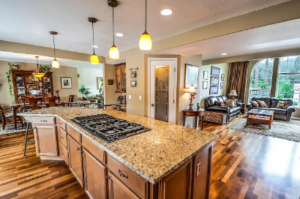Kitchens are an essential part of a home, where cooking, eating, and socialising all take place. Here are some tips for designing a practical and functional kitchen.
 Ensure your design is well-planned and that everything you need is within reach. It includes kitchen storage, with separate spaces for items like spice jars and cutlery.
Ensure your design is well-planned and that everything you need is within reach. It includes kitchen storage, with separate spaces for items like spice jars and cutlery.
Consider the Layout
Getting the kitchen layout right is crucial. It isn’t just about making it work for how you use your JAG kitchens Adelaide – that’s important too, but it also needs to be visually appealing. For example, consider placing your sink near the window so you can enjoy the view while you do the dishes. It’s a great way to get the most out of your space and integrate functionality with design.
Efficient traffic flow is another important consideration when designing a kitchen. It’s all too easy to collide with family members as they rush around in the morning if you’re not careful, so take time to map out your routes and habits to ensure that everyone’s movements don’t interfere.
The kitchen triangle is a popular design principle that suggests the fridge, sink, and oven should form an imaginary triangle to minimise movement within the kitchen. However, this rule isn’t a strict one, and you can vary it to suit your kitchen’s layout.
It’s also a good idea to place frequently used items together, such as storing cups and tea bags near the kettle or keeping all your wraps, foils and plastic containers near the sink for easier unloading. It saves time and energy and prevents you from having to hunt down those little bits and pieces that are always in the back of your cupboards.
Think about Storage
For a kitchen to be functional, it needs to have plenty of storage. It is essential for preventing clutter and ensuring that everything can be easily located. Often overlooked items like pot drawers can make all the difference. They keep everything from cooking utensils to plastic containers neatly organised without taking up valuable floor space.
Other simple ideas to consider include wall-mounted magnetic racks for knives. It saves counter space while enabling you to access and sharpen your knives easily. Alternatively, you might opt for a built-in sink with a colander or grid to increase worktop functionality and eliminate the need for additional appliances, such as an extra draining board. You could also consider a multifunctional island in JAG kitchens Adelaide that doubles as a dining table to make it more friendly for family meals or dinner parties.
When planning your new kitchen, consider the amount of time you spend in the kitchen and where the most important items will be stored. It will help you choose the right storage solutions for your needs.
Think About Lighting
A well-lit room must include a mix of ambient, task and accent lighting. Each fixture can play a different role in the kitchen, ensuring it is adaptable for cooking, eating and entertaining. Ambient lighting can be provided by overhead fixtures such as pendants or chandeliers, flush and semi-flush fittings, or even LED strip lights under cabinets. Lights with diffusers or frosted housings help minimise glare and soften the look of the fixtures.
Accent lighting is where you can really add personality to your kitchen, as it can call attention to architectural details or artwork. It’s also a great way to highlight stemware in glass cabinets and other decor elements. You can also use wall sconces or cabinet lights to accentuate these features and create an overall look.
Think About Appliances
Aside from the obvious, kitchens must function as well as they look. A good designer will consider what appliances you require and plan the layout around these. Adding elements at the eleventh hour can create an awkward space and lead to electrical issues that may not have been foreseen.
The layout of a kitchen is based on the work zones that will be required for your family to cook, clean up and dine/entertain. There should be no more than three meters between the refrigerator, oven and sink, for example. It is called the ‘work triangle’, and it makes for a functional kitchen.
